Management of Human Resources: An Analysis of the Enron Case Study
VerifiedAdded on 2023/06/09
|11
|2916
|253
Case Study
AI Summary
This case study examines the Enron Corporation, focusing on its human resource management practices, strategic choices, and leadership failures that led to its dramatic collapse. It begins with an overview of Enron's history, its shift from natural gas transportation to unregulated energy trading, and its rapid growth followed by an equally rapid decline. The analysis critically evaluates Enron's strategic decisions, such as investments in high-tech communication and foreign ventures, highlighting how these choices impacted the company's long-term sustainability. The study also identifies the missing links in Enron's leadership, particularly the roles of Kenneth Lay and Jeffrey Skilling, and how their actions fostered a culture of unethical behavior and internal competition. The essay provides recommendations for Kenneth Lay, emphasizing the importance of ethical leadership, improved governance, and corporate social responsibility to maintain profitability. The case study underscores the significance of transparency, ethical conduct, and sound management practices in ensuring corporate success and preventing financial scandals.
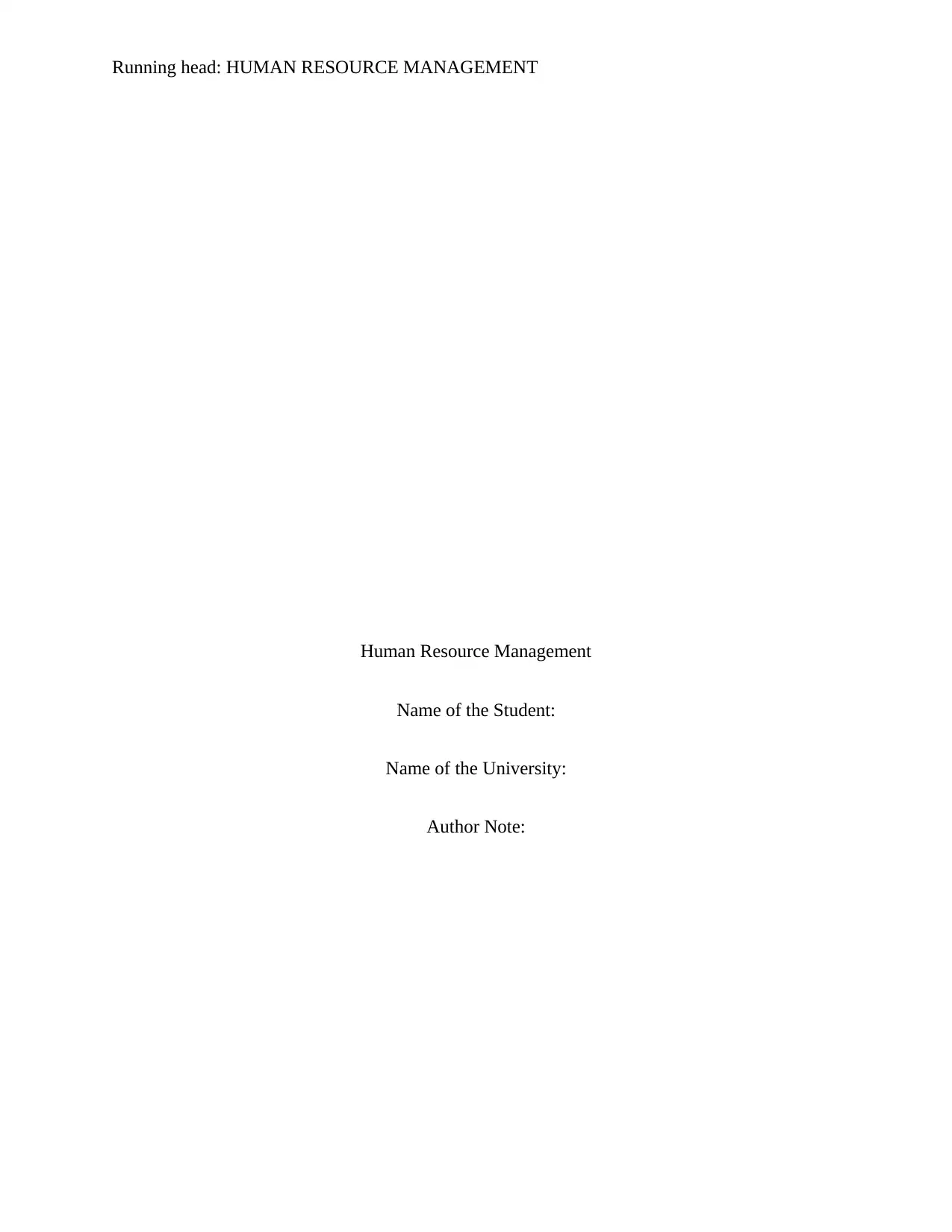
Running head: HUMAN RESOURCE MANAGEMENT
Human Resource Management
Name of the Student:
Name of the University:
Author Note:
Human Resource Management
Name of the Student:
Name of the University:
Author Note:
Paraphrase This Document
Need a fresh take? Get an instant paraphrase of this document with our AI Paraphraser
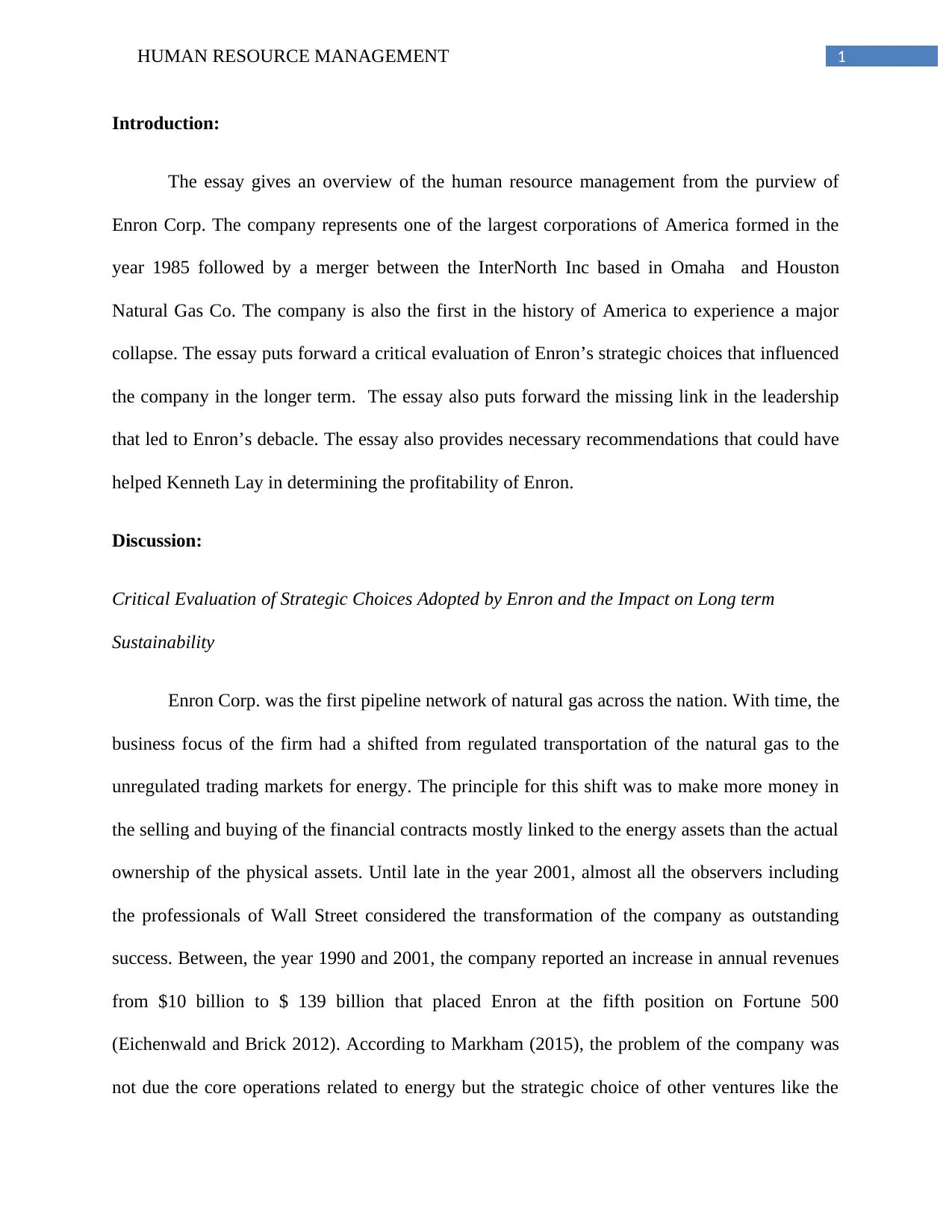
1HUMAN RESOURCE MANAGEMENT
Introduction:
The essay gives an overview of the human resource management from the purview of
Enron Corp. The company represents one of the largest corporations of America formed in the
year 1985 followed by a merger between the InterNorth Inc based in Omaha and Houston
Natural Gas Co. The company is also the first in the history of America to experience a major
collapse. The essay puts forward a critical evaluation of Enron’s strategic choices that influenced
the company in the longer term. The essay also puts forward the missing link in the leadership
that led to Enron’s debacle. The essay also provides necessary recommendations that could have
helped Kenneth Lay in determining the profitability of Enron.
Discussion:
Critical Evaluation of Strategic Choices Adopted by Enron and the Impact on Long term
Sustainability
Enron Corp. was the first pipeline network of natural gas across the nation. With time, the
business focus of the firm had a shifted from regulated transportation of the natural gas to the
unregulated trading markets for energy. The principle for this shift was to make more money in
the selling and buying of the financial contracts mostly linked to the energy assets than the actual
ownership of the physical assets. Until late in the year 2001, almost all the observers including
the professionals of Wall Street considered the transformation of the company as outstanding
success. Between, the year 1990 and 2001, the company reported an increase in annual revenues
from $10 billion to $ 139 billion that placed Enron at the fifth position on Fortune 500
(Eichenwald and Brick 2012). According to Markham (2015), the problem of the company was
not due the core operations related to energy but the strategic choice of other ventures like the
Introduction:
The essay gives an overview of the human resource management from the purview of
Enron Corp. The company represents one of the largest corporations of America formed in the
year 1985 followed by a merger between the InterNorth Inc based in Omaha and Houston
Natural Gas Co. The company is also the first in the history of America to experience a major
collapse. The essay puts forward a critical evaluation of Enron’s strategic choices that influenced
the company in the longer term. The essay also puts forward the missing link in the leadership
that led to Enron’s debacle. The essay also provides necessary recommendations that could have
helped Kenneth Lay in determining the profitability of Enron.
Discussion:
Critical Evaluation of Strategic Choices Adopted by Enron and the Impact on Long term
Sustainability
Enron Corp. was the first pipeline network of natural gas across the nation. With time, the
business focus of the firm had a shifted from regulated transportation of the natural gas to the
unregulated trading markets for energy. The principle for this shift was to make more money in
the selling and buying of the financial contracts mostly linked to the energy assets than the actual
ownership of the physical assets. Until late in the year 2001, almost all the observers including
the professionals of Wall Street considered the transformation of the company as outstanding
success. Between, the year 1990 and 2001, the company reported an increase in annual revenues
from $10 billion to $ 139 billion that placed Enron at the fifth position on Fortune 500
(Eichenwald and Brick 2012). According to Markham (2015), the problem of the company was
not due the core operations related to energy but the strategic choice of other ventures like the
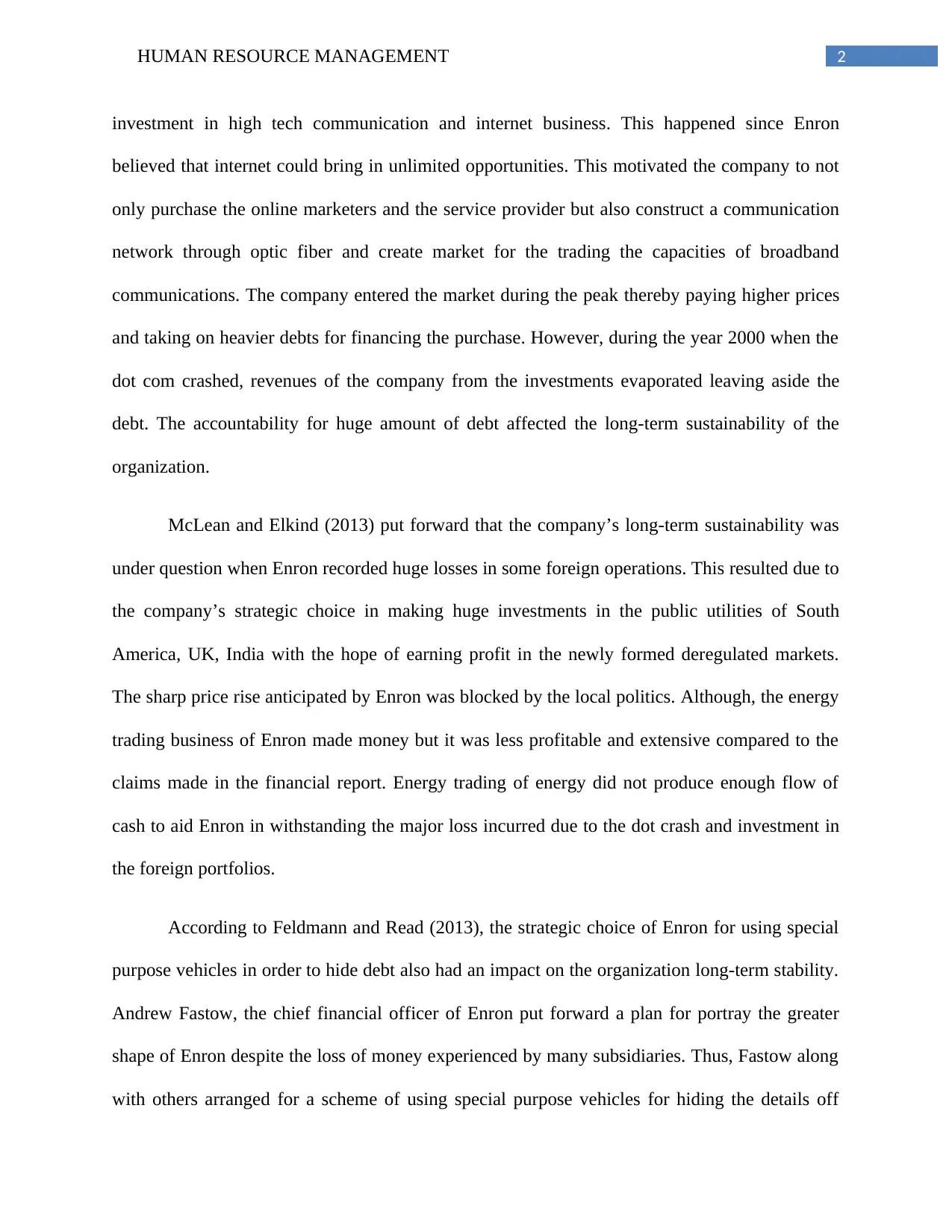
2HUMAN RESOURCE MANAGEMENT
investment in high tech communication and internet business. This happened since Enron
believed that internet could bring in unlimited opportunities. This motivated the company to not
only purchase the online marketers and the service provider but also construct a communication
network through optic fiber and create market for the trading the capacities of broadband
communications. The company entered the market during the peak thereby paying higher prices
and taking on heavier debts for financing the purchase. However, during the year 2000 when the
dot com crashed, revenues of the company from the investments evaporated leaving aside the
debt. The accountability for huge amount of debt affected the long-term sustainability of the
organization.
McLean and Elkind (2013) put forward that the company’s long-term sustainability was
under question when Enron recorded huge losses in some foreign operations. This resulted due to
the company’s strategic choice in making huge investments in the public utilities of South
America, UK, India with the hope of earning profit in the newly formed deregulated markets.
The sharp price rise anticipated by Enron was blocked by the local politics. Although, the energy
trading business of Enron made money but it was less profitable and extensive compared to the
claims made in the financial report. Energy trading of energy did not produce enough flow of
cash to aid Enron in withstanding the major loss incurred due to the dot crash and investment in
the foreign portfolios.
According to Feldmann and Read (2013), the strategic choice of Enron for using special
purpose vehicles in order to hide debt also had an impact on the organization long-term stability.
Andrew Fastow, the chief financial officer of Enron put forward a plan for portray the greater
shape of Enron despite the loss of money experienced by many subsidiaries. Thus, Fastow along
with others arranged for a scheme of using special purpose vehicles for hiding the details off
investment in high tech communication and internet business. This happened since Enron
believed that internet could bring in unlimited opportunities. This motivated the company to not
only purchase the online marketers and the service provider but also construct a communication
network through optic fiber and create market for the trading the capacities of broadband
communications. The company entered the market during the peak thereby paying higher prices
and taking on heavier debts for financing the purchase. However, during the year 2000 when the
dot com crashed, revenues of the company from the investments evaporated leaving aside the
debt. The accountability for huge amount of debt affected the long-term sustainability of the
organization.
McLean and Elkind (2013) put forward that the company’s long-term sustainability was
under question when Enron recorded huge losses in some foreign operations. This resulted due to
the company’s strategic choice in making huge investments in the public utilities of South
America, UK, India with the hope of earning profit in the newly formed deregulated markets.
The sharp price rise anticipated by Enron was blocked by the local politics. Although, the energy
trading business of Enron made money but it was less profitable and extensive compared to the
claims made in the financial report. Energy trading of energy did not produce enough flow of
cash to aid Enron in withstanding the major loss incurred due to the dot crash and investment in
the foreign portfolios.
According to Feldmann and Read (2013), the strategic choice of Enron for using special
purpose vehicles in order to hide debt also had an impact on the organization long-term stability.
Andrew Fastow, the chief financial officer of Enron put forward a plan for portray the greater
shape of Enron despite the loss of money experienced by many subsidiaries. Thus, Fastow along
with others arranged for a scheme of using special purpose vehicles for hiding the details off
⊘ This is a preview!⊘
Do you want full access?
Subscribe today to unlock all pages.

Trusted by 1+ million students worldwide
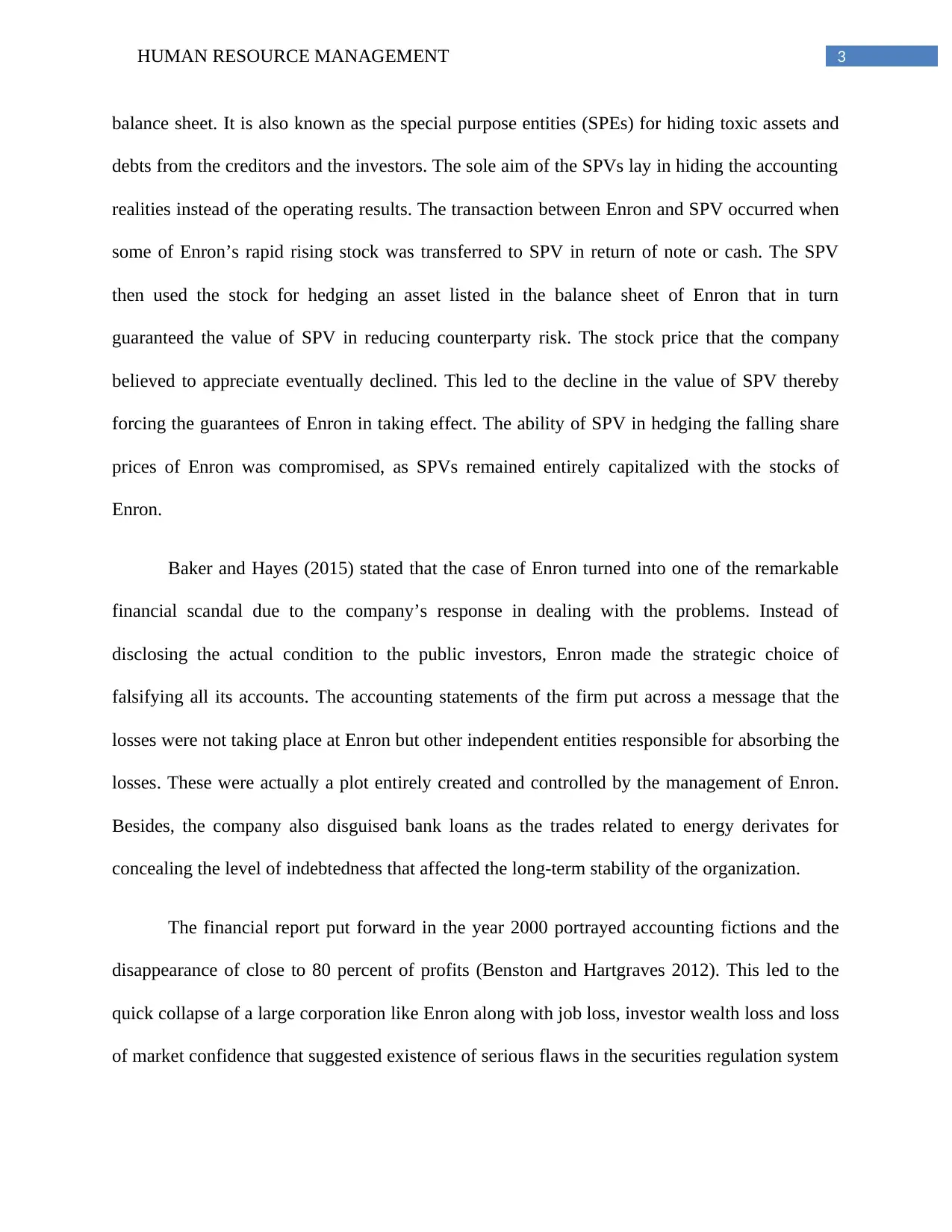
3HUMAN RESOURCE MANAGEMENT
balance sheet. It is also known as the special purpose entities (SPEs) for hiding toxic assets and
debts from the creditors and the investors. The sole aim of the SPVs lay in hiding the accounting
realities instead of the operating results. The transaction between Enron and SPV occurred when
some of Enron’s rapid rising stock was transferred to SPV in return of note or cash. The SPV
then used the stock for hedging an asset listed in the balance sheet of Enron that in turn
guaranteed the value of SPV in reducing counterparty risk. The stock price that the company
believed to appreciate eventually declined. This led to the decline in the value of SPV thereby
forcing the guarantees of Enron in taking effect. The ability of SPV in hedging the falling share
prices of Enron was compromised, as SPVs remained entirely capitalized with the stocks of
Enron.
Baker and Hayes (2015) stated that the case of Enron turned into one of the remarkable
financial scandal due to the company’s response in dealing with the problems. Instead of
disclosing the actual condition to the public investors, Enron made the strategic choice of
falsifying all its accounts. The accounting statements of the firm put across a message that the
losses were not taking place at Enron but other independent entities responsible for absorbing the
losses. These were actually a plot entirely created and controlled by the management of Enron.
Besides, the company also disguised bank loans as the trades related to energy derivates for
concealing the level of indebtedness that affected the long-term stability of the organization.
The financial report put forward in the year 2000 portrayed accounting fictions and the
disappearance of close to 80 percent of profits (Benston and Hartgraves 2012). This led to the
quick collapse of a large corporation like Enron along with job loss, investor wealth loss and loss
of market confidence that suggested existence of serious flaws in the securities regulation system
balance sheet. It is also known as the special purpose entities (SPEs) for hiding toxic assets and
debts from the creditors and the investors. The sole aim of the SPVs lay in hiding the accounting
realities instead of the operating results. The transaction between Enron and SPV occurred when
some of Enron’s rapid rising stock was transferred to SPV in return of note or cash. The SPV
then used the stock for hedging an asset listed in the balance sheet of Enron that in turn
guaranteed the value of SPV in reducing counterparty risk. The stock price that the company
believed to appreciate eventually declined. This led to the decline in the value of SPV thereby
forcing the guarantees of Enron in taking effect. The ability of SPV in hedging the falling share
prices of Enron was compromised, as SPVs remained entirely capitalized with the stocks of
Enron.
Baker and Hayes (2015) stated that the case of Enron turned into one of the remarkable
financial scandal due to the company’s response in dealing with the problems. Instead of
disclosing the actual condition to the public investors, Enron made the strategic choice of
falsifying all its accounts. The accounting statements of the firm put across a message that the
losses were not taking place at Enron but other independent entities responsible for absorbing the
losses. These were actually a plot entirely created and controlled by the management of Enron.
Besides, the company also disguised bank loans as the trades related to energy derivates for
concealing the level of indebtedness that affected the long-term stability of the organization.
The financial report put forward in the year 2000 portrayed accounting fictions and the
disappearance of close to 80 percent of profits (Benston and Hartgraves 2012). This led to the
quick collapse of a large corporation like Enron along with job loss, investor wealth loss and loss
of market confidence that suggested existence of serious flaws in the securities regulation system
Paraphrase This Document
Need a fresh take? Get an instant paraphrase of this document with our AI Paraphraser
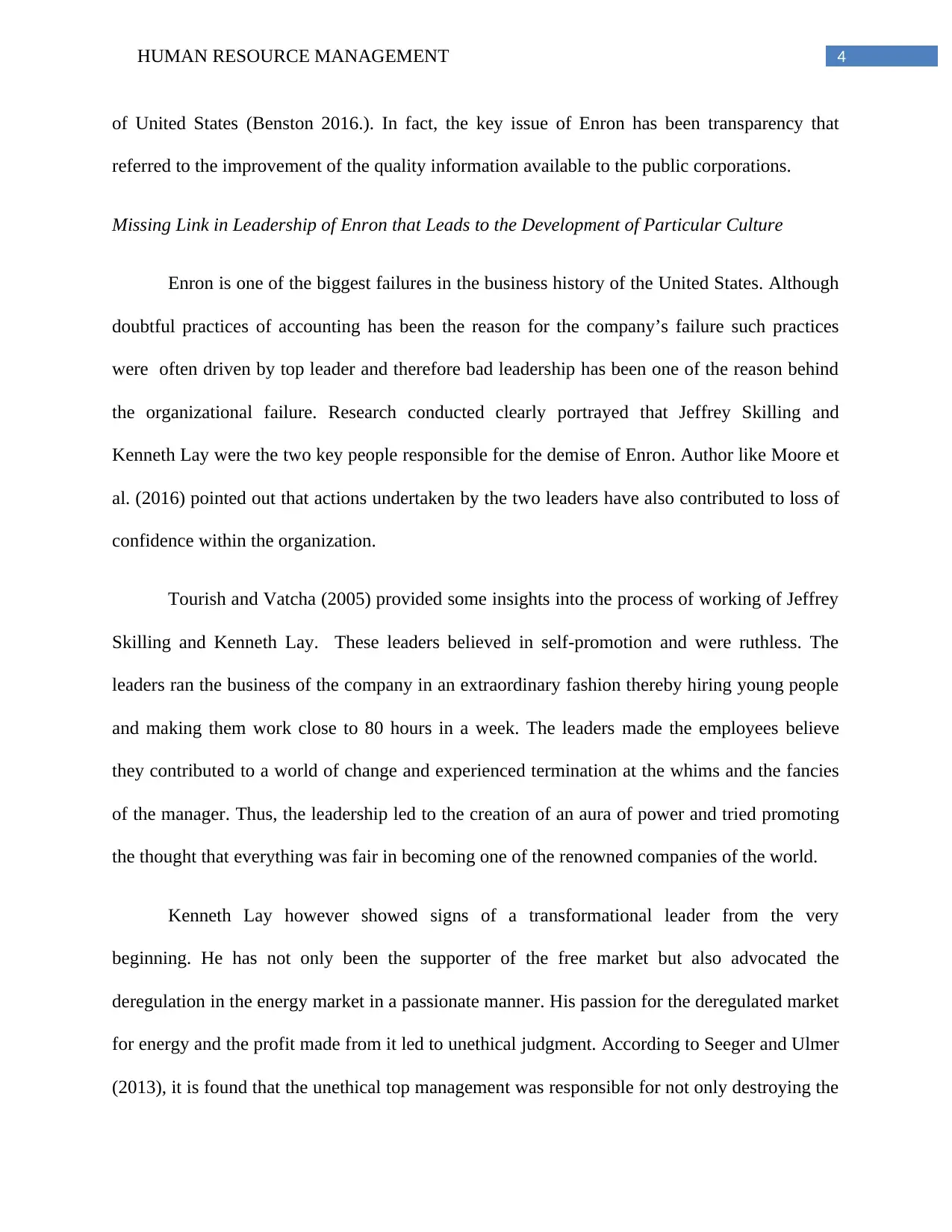
4HUMAN RESOURCE MANAGEMENT
of United States (Benston 2016.). In fact, the key issue of Enron has been transparency that
referred to the improvement of the quality information available to the public corporations.
Missing Link in Leadership of Enron that Leads to the Development of Particular Culture
Enron is one of the biggest failures in the business history of the United States. Although
doubtful practices of accounting has been the reason for the company’s failure such practices
were often driven by top leader and therefore bad leadership has been one of the reason behind
the organizational failure. Research conducted clearly portrayed that Jeffrey Skilling and
Kenneth Lay were the two key people responsible for the demise of Enron. Author like Moore et
al. (2016) pointed out that actions undertaken by the two leaders have also contributed to loss of
confidence within the organization.
Tourish and Vatcha (2005) provided some insights into the process of working of Jeffrey
Skilling and Kenneth Lay. These leaders believed in self-promotion and were ruthless. The
leaders ran the business of the company in an extraordinary fashion thereby hiring young people
and making them work close to 80 hours in a week. The leaders made the employees believe
they contributed to a world of change and experienced termination at the whims and the fancies
of the manager. Thus, the leadership led to the creation of an aura of power and tried promoting
the thought that everything was fair in becoming one of the renowned companies of the world.
Kenneth Lay however showed signs of a transformational leader from the very
beginning. He has not only been the supporter of the free market but also advocated the
deregulation in the energy market in a passionate manner. His passion for the deregulated market
for energy and the profit made from it led to unethical judgment. According to Seeger and Ulmer
(2013), it is found that the unethical top management was responsible for not only destroying the
of United States (Benston 2016.). In fact, the key issue of Enron has been transparency that
referred to the improvement of the quality information available to the public corporations.
Missing Link in Leadership of Enron that Leads to the Development of Particular Culture
Enron is one of the biggest failures in the business history of the United States. Although
doubtful practices of accounting has been the reason for the company’s failure such practices
were often driven by top leader and therefore bad leadership has been one of the reason behind
the organizational failure. Research conducted clearly portrayed that Jeffrey Skilling and
Kenneth Lay were the two key people responsible for the demise of Enron. Author like Moore et
al. (2016) pointed out that actions undertaken by the two leaders have also contributed to loss of
confidence within the organization.
Tourish and Vatcha (2005) provided some insights into the process of working of Jeffrey
Skilling and Kenneth Lay. These leaders believed in self-promotion and were ruthless. The
leaders ran the business of the company in an extraordinary fashion thereby hiring young people
and making them work close to 80 hours in a week. The leaders made the employees believe
they contributed to a world of change and experienced termination at the whims and the fancies
of the manager. Thus, the leadership led to the creation of an aura of power and tried promoting
the thought that everything was fair in becoming one of the renowned companies of the world.
Kenneth Lay however showed signs of a transformational leader from the very
beginning. He has not only been the supporter of the free market but also advocated the
deregulation in the energy market in a passionate manner. His passion for the deregulated market
for energy and the profit made from it led to unethical judgment. According to Seeger and Ulmer
(2013), it is found that the unethical top management was responsible for not only destroying the
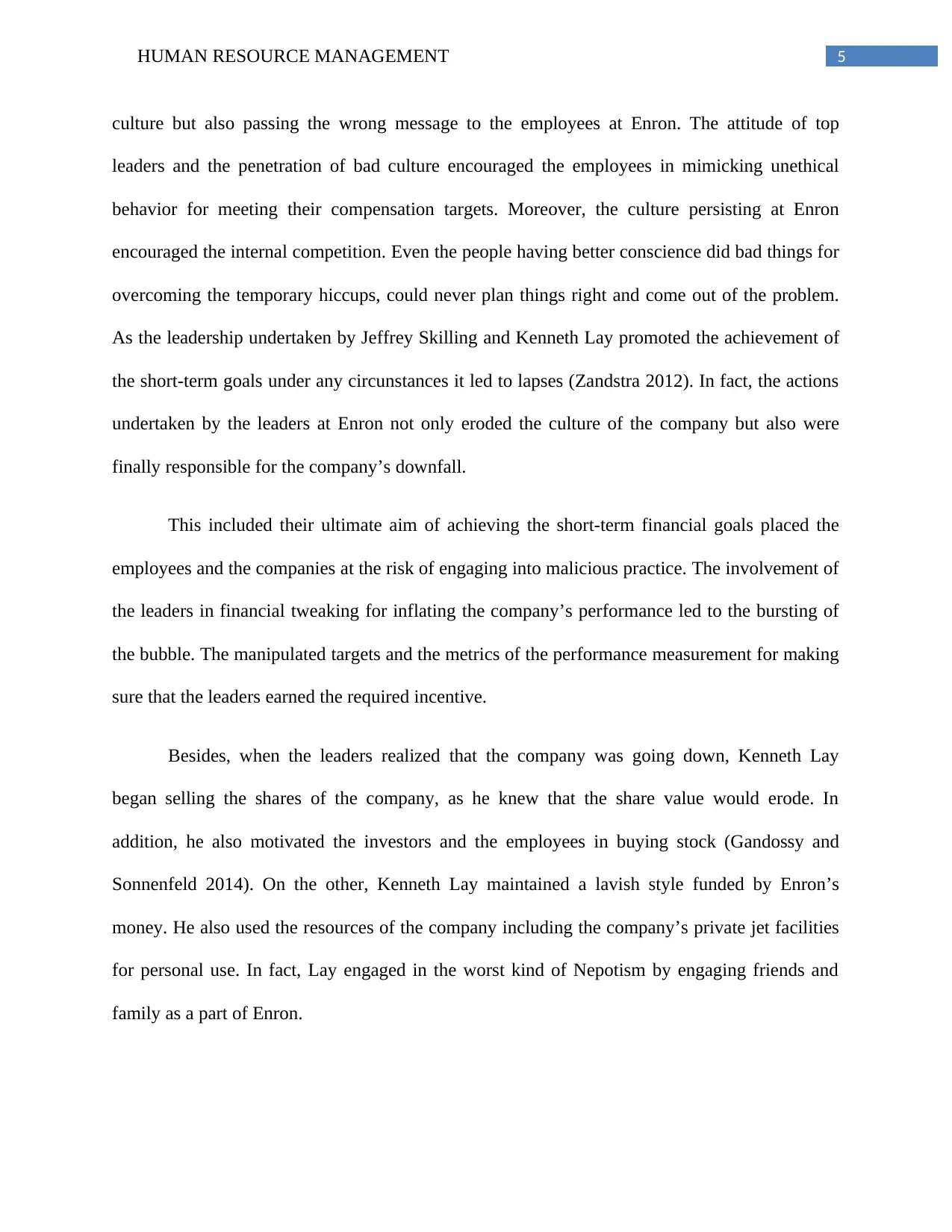
5HUMAN RESOURCE MANAGEMENT
culture but also passing the wrong message to the employees at Enron. The attitude of top
leaders and the penetration of bad culture encouraged the employees in mimicking unethical
behavior for meeting their compensation targets. Moreover, the culture persisting at Enron
encouraged the internal competition. Even the people having better conscience did bad things for
overcoming the temporary hiccups, could never plan things right and come out of the problem.
As the leadership undertaken by Jeffrey Skilling and Kenneth Lay promoted the achievement of
the short-term goals under any circunstances it led to lapses (Zandstra 2012). In fact, the actions
undertaken by the leaders at Enron not only eroded the culture of the company but also were
finally responsible for the company’s downfall.
This included their ultimate aim of achieving the short-term financial goals placed the
employees and the companies at the risk of engaging into malicious practice. The involvement of
the leaders in financial tweaking for inflating the company’s performance led to the bursting of
the bubble. The manipulated targets and the metrics of the performance measurement for making
sure that the leaders earned the required incentive.
Besides, when the leaders realized that the company was going down, Kenneth Lay
began selling the shares of the company, as he knew that the share value would erode. In
addition, he also motivated the investors and the employees in buying stock (Gandossy and
Sonnenfeld 2014). On the other, Kenneth Lay maintained a lavish style funded by Enron’s
money. He also used the resources of the company including the company’s private jet facilities
for personal use. In fact, Lay engaged in the worst kind of Nepotism by engaging friends and
family as a part of Enron.
culture but also passing the wrong message to the employees at Enron. The attitude of top
leaders and the penetration of bad culture encouraged the employees in mimicking unethical
behavior for meeting their compensation targets. Moreover, the culture persisting at Enron
encouraged the internal competition. Even the people having better conscience did bad things for
overcoming the temporary hiccups, could never plan things right and come out of the problem.
As the leadership undertaken by Jeffrey Skilling and Kenneth Lay promoted the achievement of
the short-term goals under any circunstances it led to lapses (Zandstra 2012). In fact, the actions
undertaken by the leaders at Enron not only eroded the culture of the company but also were
finally responsible for the company’s downfall.
This included their ultimate aim of achieving the short-term financial goals placed the
employees and the companies at the risk of engaging into malicious practice. The involvement of
the leaders in financial tweaking for inflating the company’s performance led to the bursting of
the bubble. The manipulated targets and the metrics of the performance measurement for making
sure that the leaders earned the required incentive.
Besides, when the leaders realized that the company was going down, Kenneth Lay
began selling the shares of the company, as he knew that the share value would erode. In
addition, he also motivated the investors and the employees in buying stock (Gandossy and
Sonnenfeld 2014). On the other, Kenneth Lay maintained a lavish style funded by Enron’s
money. He also used the resources of the company including the company’s private jet facilities
for personal use. In fact, Lay engaged in the worst kind of Nepotism by engaging friends and
family as a part of Enron.
⊘ This is a preview!⊘
Do you want full access?
Subscribe today to unlock all pages.

Trusted by 1+ million students worldwide
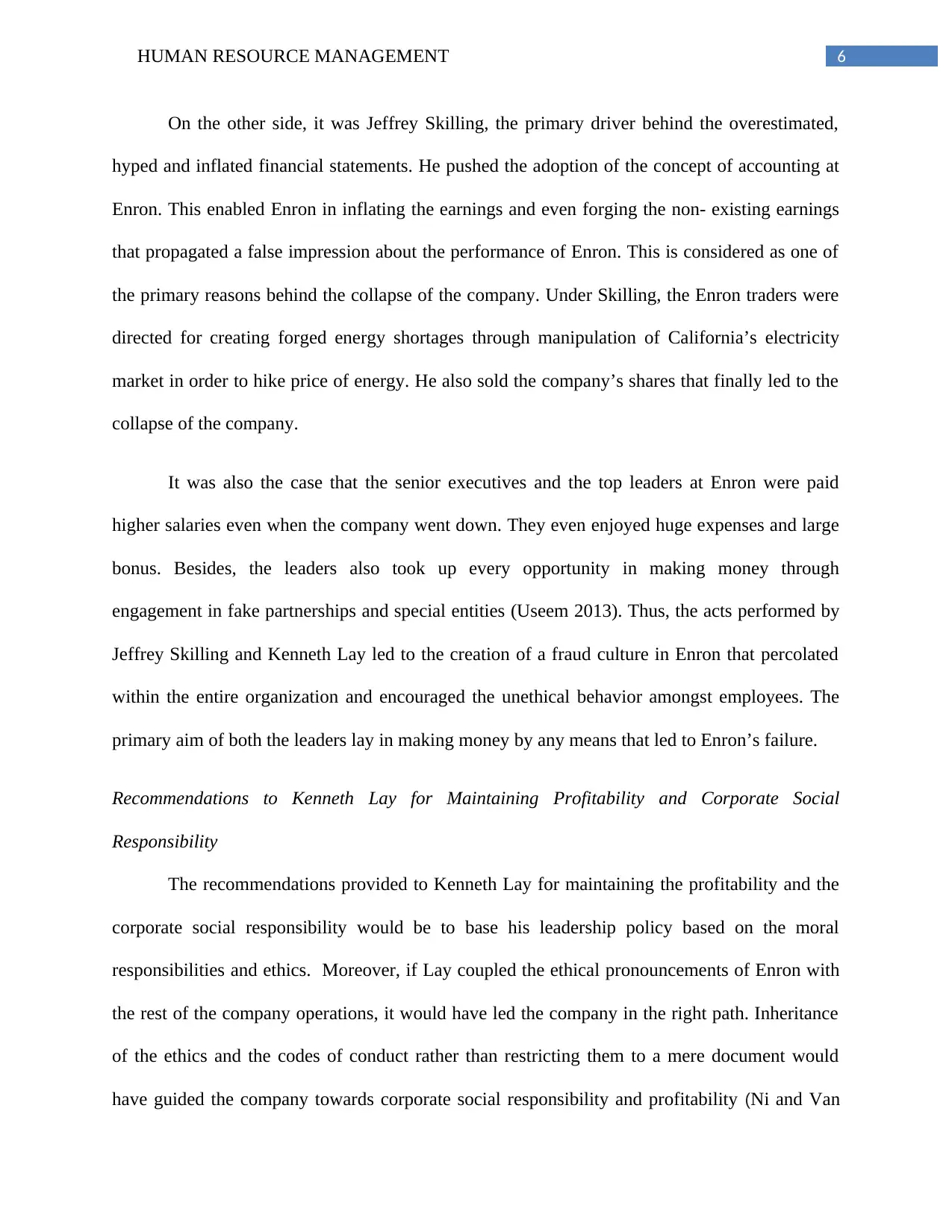
6HUMAN RESOURCE MANAGEMENT
On the other side, it was Jeffrey Skilling, the primary driver behind the overestimated,
hyped and inflated financial statements. He pushed the adoption of the concept of accounting at
Enron. This enabled Enron in inflating the earnings and even forging the non- existing earnings
that propagated a false impression about the performance of Enron. This is considered as one of
the primary reasons behind the collapse of the company. Under Skilling, the Enron traders were
directed for creating forged energy shortages through manipulation of California’s electricity
market in order to hike price of energy. He also sold the company’s shares that finally led to the
collapse of the company.
It was also the case that the senior executives and the top leaders at Enron were paid
higher salaries even when the company went down. They even enjoyed huge expenses and large
bonus. Besides, the leaders also took up every opportunity in making money through
engagement in fake partnerships and special entities (Useem 2013). Thus, the acts performed by
Jeffrey Skilling and Kenneth Lay led to the creation of a fraud culture in Enron that percolated
within the entire organization and encouraged the unethical behavior amongst employees. The
primary aim of both the leaders lay in making money by any means that led to Enron’s failure.
Recommendations to Kenneth Lay for Maintaining Profitability and Corporate Social
Responsibility
The recommendations provided to Kenneth Lay for maintaining the profitability and the
corporate social responsibility would be to base his leadership policy based on the moral
responsibilities and ethics. Moreover, if Lay coupled the ethical pronouncements of Enron with
the rest of the company operations, it would have led the company in the right path. Inheritance
of the ethics and the codes of conduct rather than restricting them to a mere document would
have guided the company towards corporate social responsibility and profitability (Ni and Van
On the other side, it was Jeffrey Skilling, the primary driver behind the overestimated,
hyped and inflated financial statements. He pushed the adoption of the concept of accounting at
Enron. This enabled Enron in inflating the earnings and even forging the non- existing earnings
that propagated a false impression about the performance of Enron. This is considered as one of
the primary reasons behind the collapse of the company. Under Skilling, the Enron traders were
directed for creating forged energy shortages through manipulation of California’s electricity
market in order to hike price of energy. He also sold the company’s shares that finally led to the
collapse of the company.
It was also the case that the senior executives and the top leaders at Enron were paid
higher salaries even when the company went down. They even enjoyed huge expenses and large
bonus. Besides, the leaders also took up every opportunity in making money through
engagement in fake partnerships and special entities (Useem 2013). Thus, the acts performed by
Jeffrey Skilling and Kenneth Lay led to the creation of a fraud culture in Enron that percolated
within the entire organization and encouraged the unethical behavior amongst employees. The
primary aim of both the leaders lay in making money by any means that led to Enron’s failure.
Recommendations to Kenneth Lay for Maintaining Profitability and Corporate Social
Responsibility
The recommendations provided to Kenneth Lay for maintaining the profitability and the
corporate social responsibility would be to base his leadership policy based on the moral
responsibilities and ethics. Moreover, if Lay coupled the ethical pronouncements of Enron with
the rest of the company operations, it would have led the company in the right path. Inheritance
of the ethics and the codes of conduct rather than restricting them to a mere document would
have guided the company towards corporate social responsibility and profitability (Ni and Van
Paraphrase This Document
Need a fresh take? Get an instant paraphrase of this document with our AI Paraphraser
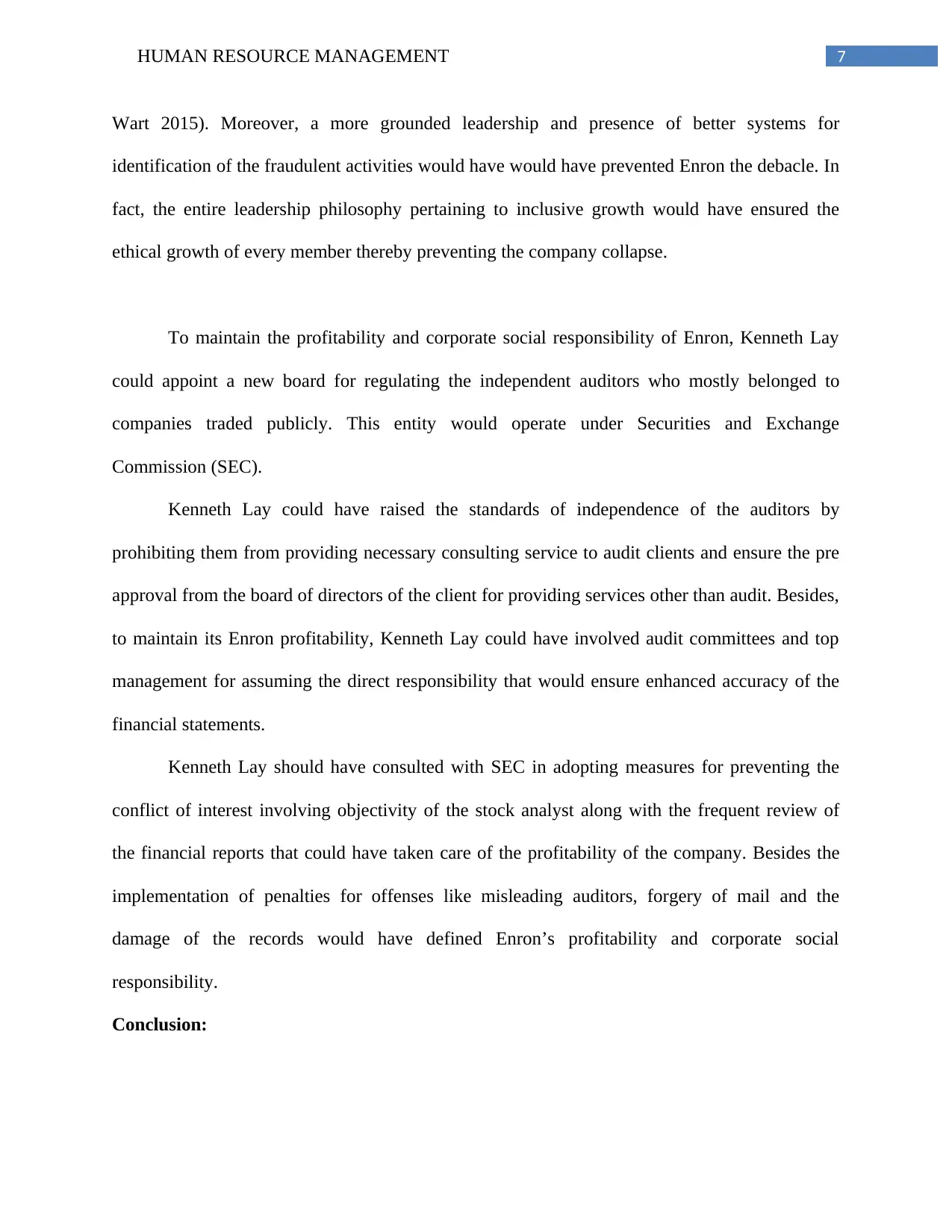
7HUMAN RESOURCE MANAGEMENT
Wart 2015). Moreover, a more grounded leadership and presence of better systems for
identification of the fraudulent activities would have would have prevented Enron the debacle. In
fact, the entire leadership philosophy pertaining to inclusive growth would have ensured the
ethical growth of every member thereby preventing the company collapse.
To maintain the profitability and corporate social responsibility of Enron, Kenneth Lay
could appoint a new board for regulating the independent auditors who mostly belonged to
companies traded publicly. This entity would operate under Securities and Exchange
Commission (SEC).
Kenneth Lay could have raised the standards of independence of the auditors by
prohibiting them from providing necessary consulting service to audit clients and ensure the pre
approval from the board of directors of the client for providing services other than audit. Besides,
to maintain its Enron profitability, Kenneth Lay could have involved audit committees and top
management for assuming the direct responsibility that would ensure enhanced accuracy of the
financial statements.
Kenneth Lay should have consulted with SEC in adopting measures for preventing the
conflict of interest involving objectivity of the stock analyst along with the frequent review of
the financial reports that could have taken care of the profitability of the company. Besides the
implementation of penalties for offenses like misleading auditors, forgery of mail and the
damage of the records would have defined Enron’s profitability and corporate social
responsibility.
Conclusion:
Wart 2015). Moreover, a more grounded leadership and presence of better systems for
identification of the fraudulent activities would have would have prevented Enron the debacle. In
fact, the entire leadership philosophy pertaining to inclusive growth would have ensured the
ethical growth of every member thereby preventing the company collapse.
To maintain the profitability and corporate social responsibility of Enron, Kenneth Lay
could appoint a new board for regulating the independent auditors who mostly belonged to
companies traded publicly. This entity would operate under Securities and Exchange
Commission (SEC).
Kenneth Lay could have raised the standards of independence of the auditors by
prohibiting them from providing necessary consulting service to audit clients and ensure the pre
approval from the board of directors of the client for providing services other than audit. Besides,
to maintain its Enron profitability, Kenneth Lay could have involved audit committees and top
management for assuming the direct responsibility that would ensure enhanced accuracy of the
financial statements.
Kenneth Lay should have consulted with SEC in adopting measures for preventing the
conflict of interest involving objectivity of the stock analyst along with the frequent review of
the financial reports that could have taken care of the profitability of the company. Besides the
implementation of penalties for offenses like misleading auditors, forgery of mail and the
damage of the records would have defined Enron’s profitability and corporate social
responsibility.
Conclusion:
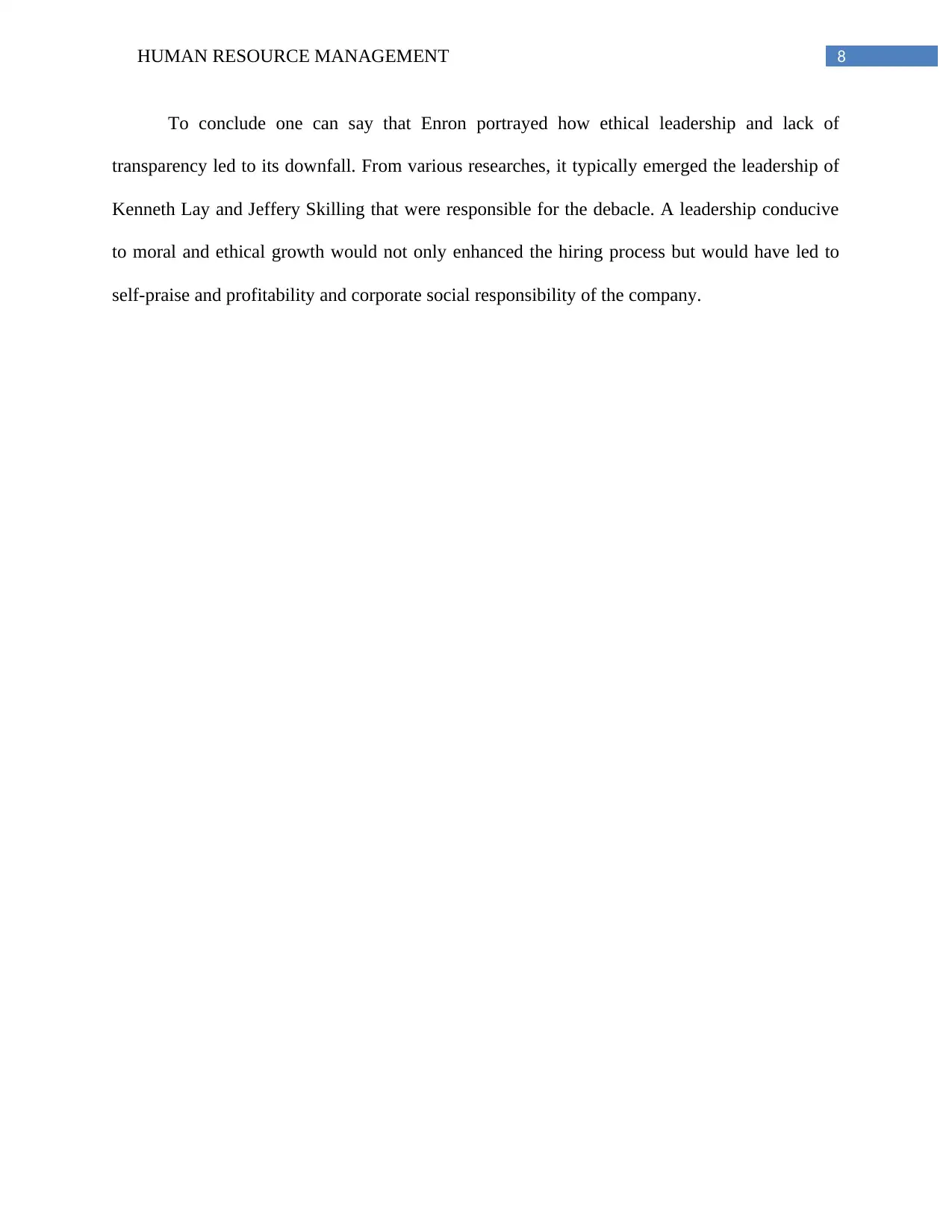
8HUMAN RESOURCE MANAGEMENT
To conclude one can say that Enron portrayed how ethical leadership and lack of
transparency led to its downfall. From various researches, it typically emerged the leadership of
Kenneth Lay and Jeffery Skilling that were responsible for the debacle. A leadership conducive
to moral and ethical growth would not only enhanced the hiring process but would have led to
self-praise and profitability and corporate social responsibility of the company.
To conclude one can say that Enron portrayed how ethical leadership and lack of
transparency led to its downfall. From various researches, it typically emerged the leadership of
Kenneth Lay and Jeffery Skilling that were responsible for the debacle. A leadership conducive
to moral and ethical growth would not only enhanced the hiring process but would have led to
self-praise and profitability and corporate social responsibility of the company.
⊘ This is a preview!⊘
Do you want full access?
Subscribe today to unlock all pages.

Trusted by 1+ million students worldwide
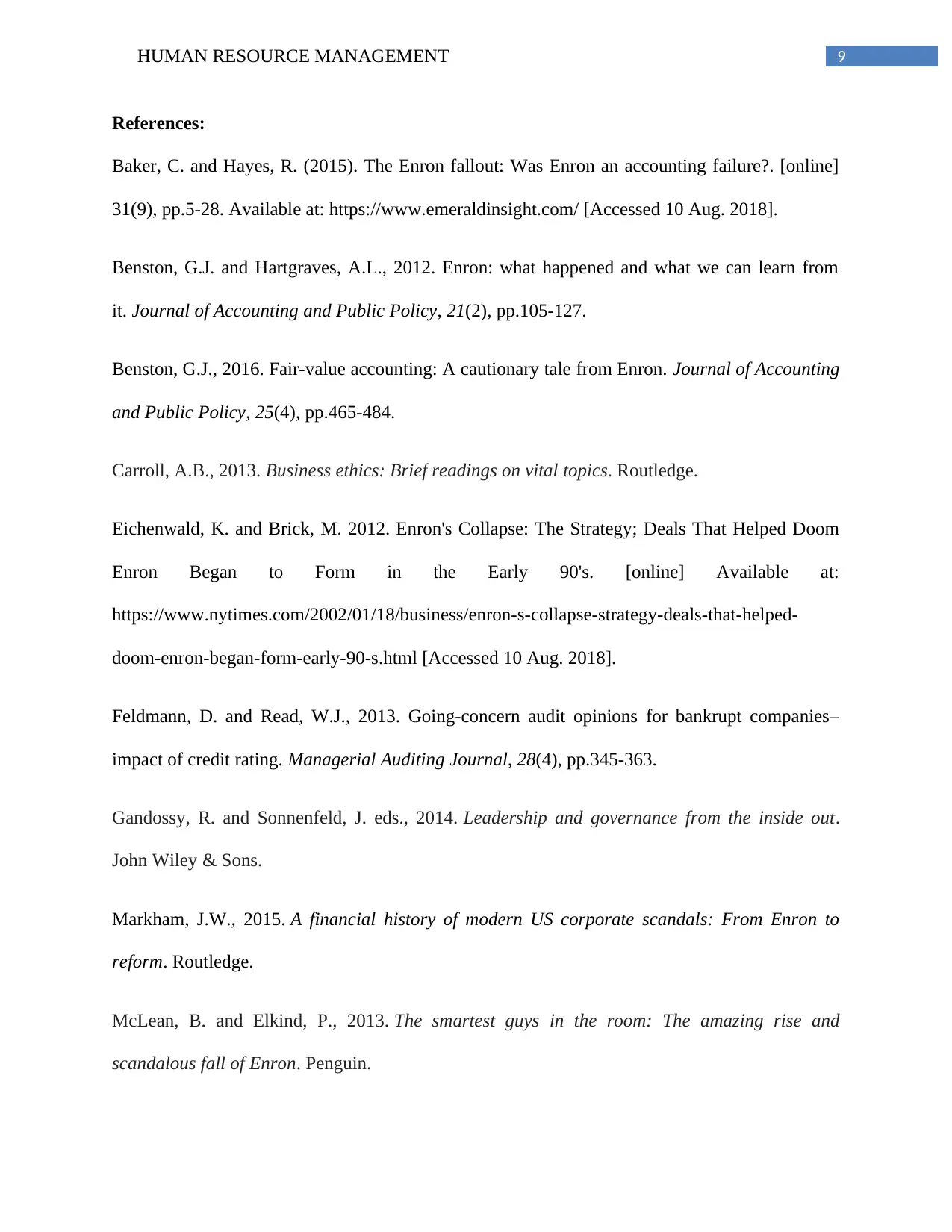
9HUMAN RESOURCE MANAGEMENT
References:
Baker, C. and Hayes, R. (2015). The Enron fallout: Was Enron an accounting failure?. [online]
31(9), pp.5-28. Available at: https://www.emeraldinsight.com/ [Accessed 10 Aug. 2018].
Benston, G.J. and Hartgraves, A.L., 2012. Enron: what happened and what we can learn from
it. Journal of Accounting and Public Policy, 21(2), pp.105-127.
Benston, G.J., 2016. Fair-value accounting: A cautionary tale from Enron. Journal of Accounting
and Public Policy, 25(4), pp.465-484.
Carroll, A.B., 2013. Business ethics: Brief readings on vital topics. Routledge.
Eichenwald, K. and Brick, M. 2012. Enron's Collapse: The Strategy; Deals That Helped Doom
Enron Began to Form in the Early 90's. [online] Available at:
https://www.nytimes.com/2002/01/18/business/enron-s-collapse-strategy-deals-that-helped-
doom-enron-began-form-early-90-s.html [Accessed 10 Aug. 2018].
Feldmann, D. and Read, W.J., 2013. Going-concern audit opinions for bankrupt companies–
impact of credit rating. Managerial Auditing Journal, 28(4), pp.345-363.
Gandossy, R. and Sonnenfeld, J. eds., 2014. Leadership and governance from the inside out.
John Wiley & Sons.
Markham, J.W., 2015. A financial history of modern US corporate scandals: From Enron to
reform. Routledge.
McLean, B. and Elkind, P., 2013. The smartest guys in the room: The amazing rise and
scandalous fall of Enron. Penguin.
References:
Baker, C. and Hayes, R. (2015). The Enron fallout: Was Enron an accounting failure?. [online]
31(9), pp.5-28. Available at: https://www.emeraldinsight.com/ [Accessed 10 Aug. 2018].
Benston, G.J. and Hartgraves, A.L., 2012. Enron: what happened and what we can learn from
it. Journal of Accounting and Public Policy, 21(2), pp.105-127.
Benston, G.J., 2016. Fair-value accounting: A cautionary tale from Enron. Journal of Accounting
and Public Policy, 25(4), pp.465-484.
Carroll, A.B., 2013. Business ethics: Brief readings on vital topics. Routledge.
Eichenwald, K. and Brick, M. 2012. Enron's Collapse: The Strategy; Deals That Helped Doom
Enron Began to Form in the Early 90's. [online] Available at:
https://www.nytimes.com/2002/01/18/business/enron-s-collapse-strategy-deals-that-helped-
doom-enron-began-form-early-90-s.html [Accessed 10 Aug. 2018].
Feldmann, D. and Read, W.J., 2013. Going-concern audit opinions for bankrupt companies–
impact of credit rating. Managerial Auditing Journal, 28(4), pp.345-363.
Gandossy, R. and Sonnenfeld, J. eds., 2014. Leadership and governance from the inside out.
John Wiley & Sons.
Markham, J.W., 2015. A financial history of modern US corporate scandals: From Enron to
reform. Routledge.
McLean, B. and Elkind, P., 2013. The smartest guys in the room: The amazing rise and
scandalous fall of Enron. Penguin.
Paraphrase This Document
Need a fresh take? Get an instant paraphrase of this document with our AI Paraphraser
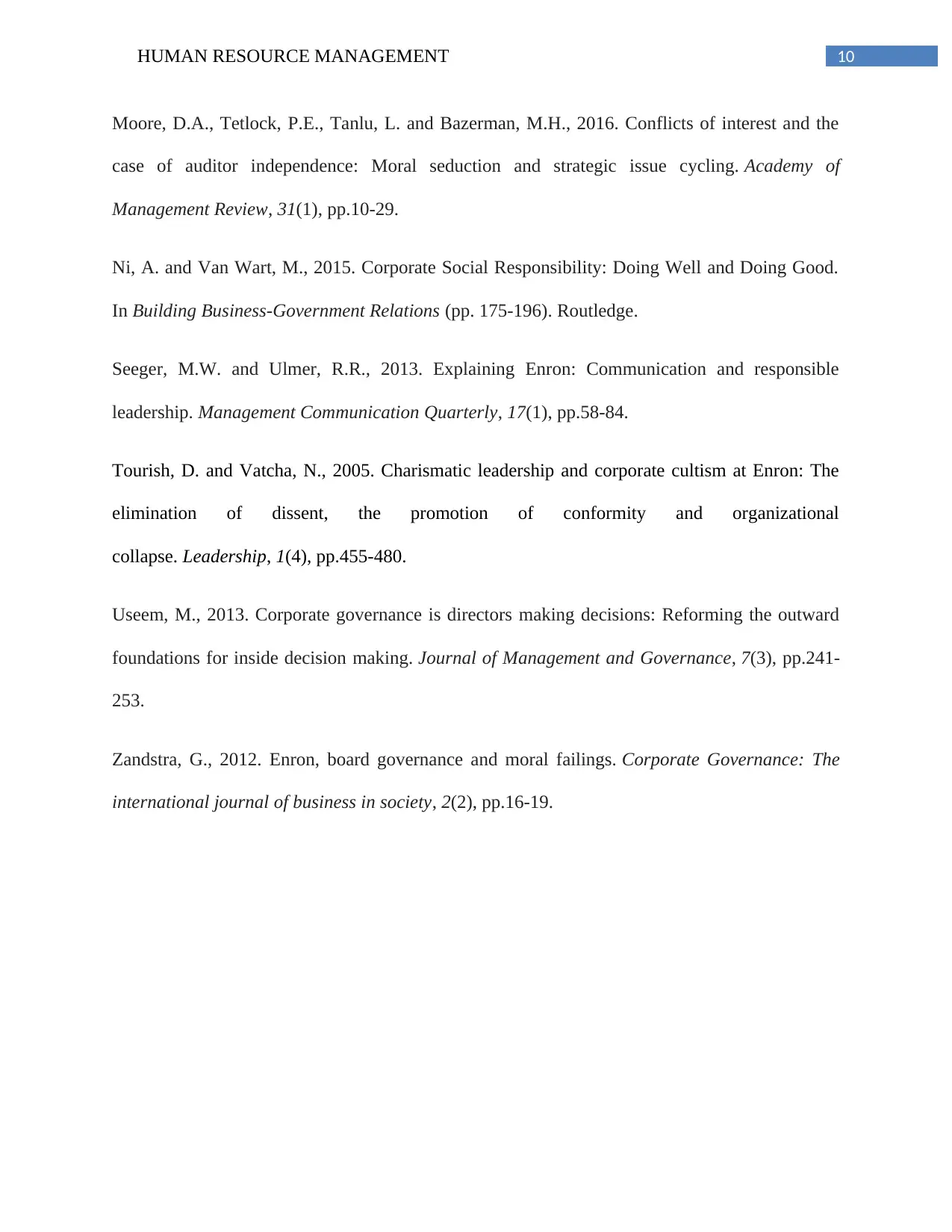
10HUMAN RESOURCE MANAGEMENT
Moore, D.A., Tetlock, P.E., Tanlu, L. and Bazerman, M.H., 2016. Conflicts of interest and the
case of auditor independence: Moral seduction and strategic issue cycling. Academy of
Management Review, 31(1), pp.10-29.
Ni, A. and Van Wart, M., 2015. Corporate Social Responsibility: Doing Well and Doing Good.
In Building Business-Government Relations (pp. 175-196). Routledge.
Seeger, M.W. and Ulmer, R.R., 2013. Explaining Enron: Communication and responsible
leadership. Management Communication Quarterly, 17(1), pp.58-84.
Tourish, D. and Vatcha, N., 2005. Charismatic leadership and corporate cultism at Enron: The
elimination of dissent, the promotion of conformity and organizational
collapse. Leadership, 1(4), pp.455-480.
Useem, M., 2013. Corporate governance is directors making decisions: Reforming the outward
foundations for inside decision making. Journal of Management and Governance, 7(3), pp.241-
253.
Zandstra, G., 2012. Enron, board governance and moral failings. Corporate Governance: The
international journal of business in society, 2(2), pp.16-19.
Moore, D.A., Tetlock, P.E., Tanlu, L. and Bazerman, M.H., 2016. Conflicts of interest and the
case of auditor independence: Moral seduction and strategic issue cycling. Academy of
Management Review, 31(1), pp.10-29.
Ni, A. and Van Wart, M., 2015. Corporate Social Responsibility: Doing Well and Doing Good.
In Building Business-Government Relations (pp. 175-196). Routledge.
Seeger, M.W. and Ulmer, R.R., 2013. Explaining Enron: Communication and responsible
leadership. Management Communication Quarterly, 17(1), pp.58-84.
Tourish, D. and Vatcha, N., 2005. Charismatic leadership and corporate cultism at Enron: The
elimination of dissent, the promotion of conformity and organizational
collapse. Leadership, 1(4), pp.455-480.
Useem, M., 2013. Corporate governance is directors making decisions: Reforming the outward
foundations for inside decision making. Journal of Management and Governance, 7(3), pp.241-
253.
Zandstra, G., 2012. Enron, board governance and moral failings. Corporate Governance: The
international journal of business in society, 2(2), pp.16-19.
1 out of 11
Related Documents
Your All-in-One AI-Powered Toolkit for Academic Success.
+13062052269
info@desklib.com
Available 24*7 on WhatsApp / Email
![[object Object]](/_next/static/media/star-bottom.7253800d.svg)
Unlock your academic potential
Copyright © 2020–2025 A2Z Services. All Rights Reserved. Developed and managed by ZUCOL.





